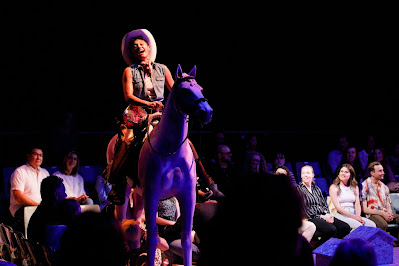by Richard Rodgers and Oscar Hammerstein III
Black Swan State Theatre Company
Directed by Richard Carroll
Musical director Victoria Falconer
Choreographer Bernadette Lewis
Designed by Jonathon Oxlade
Sound designer Tim Collins
Lighting designer Lucy Birkenshaw
Performed by Laila Bano-Rind, Stefanie Caccamo, Andy Cook, Axel Duffy, Emily Havea, Luke Hewitt, Caroline McKenzie, Sara Reed and Cameron Taylor
The band: Victoria Falconer, Wayne Freer, Adam Gare and Jarrad Payne
Heath Ledger Theatre until December 20
 |
| Emily Havea saddles up |
So much for beautiful mornings, where the corn is as high as an elephant’s eye. I suspect if a tusker were to turn up around Tulsa, the good senator would probably bag it for a trophy.
To make matters worse, the original cast soundtrack of the musical was half of the family record collection in my (far distant) childhood (the other half, fatally, was My Fair Lady).
That’s a lot of baggage to take into Black Swan’s year-ending production of the Rodger and Hammerstein 1943 groundbreaker Oklahoma!, and my conflicting inclinations as I took my seat on the stage of the Heath Ledger were to dismiss it as a ludicrous piece of rose-coloured glassware on one hand,while insisting that not a note or step of it be changed on the other.
The director of this revival, Richard Carroll, is determined to recognize and subvert these conflicts, and the entertaining, but uneven, result is a measure of both its success and failure.
I have no particular issue with two of the striking features of the production, the casting of Emily Havea, a woman of colour, as the all-male, all-white Curly, or the introduction of anachronisms like contemporary musical styles and accouterments like cell phones.
Other, that is, than to wonder what the point of it is. Havea-as-Curly didn’t seem to me to reform the themes of the text, either in the power relationships between the characters or the romantic triangles – Curly/Laurey/Jud and Will/Ado Annie/Hakim – that occupy most of our attention throughout.
I had it put to me that it served to show that a female actor could do it. Well, yes, but I’d have thought that wasn’t in dispute.
However, the intimacy of the staging – four banks of seats surrounding within touching distance of set designer Jonathon Oxlade’s chipboard stage and the cast thereupon – was an unqualified success.
It allowed the small company of nine actors and four musicians to fill your senses, and offered an insight into the effort of a dancer’s movement, the physicality of the choreography (by Bernadette Lewis) and the making of the music (directed by Victoria Falconer).
The sheer proximity to the action excused, rather than exposed, any technical deficiencies in the singing, dancing and playing, allowing a more exuberant and informal reading of those elements that might be appropriate on a more formal and distant proscenium stage.
For that much credit is due to Falconer, who was the star of the show to my mind; her arrangements took Richard Rodger’s score back to its roots in bluegrass and jug band music and her performance, on fiddle, accordion and keyboards, singing and as an insinuating MC, was marvelous. Fans of Falconer from her series of Fringe World triumphs as half of EastEnd Cabaret would not have been surprised, but delighted, to see the other strings to her bow in full twang.
Her band of WA music luminaries, Wayne Freer (bass and tuba), Adam Gare (guitar etc) and Jarrad Payne (drums) were very fine, and the cast also hoed in with instruments as varied as autoharp and spoons. A thundering, menacing piano solo in Lonely Room from Andy Cook’s Jud Fry (off stage and vividly projected onto a string curtain) was a highlight.
The dancing, perforce, is stripped down to necessities, and mostly carried by Axel Duffy as Will Parker in Kansas City and Sara Reed subbing out Stefanie Caccamo as Laurey in the Dream Ballet that closes the First Act.
The Dream Ballet is always a strange interlude, more so with the stripped down ensemble here, although Reed, who is fun throughout the show, does very good work in it.
The emphasis in Laurey’s dream on the conflict between the cowboy and the farmhand, with Jud imagined as the henchman of a thuggish police squad attacking Curly clearly conjures up Tulsa Oklahoma’s hideous 1921 race massacre and the black lives matter movement. It’s powerfully conceived by Carrol and Lewis, even if it strains at the fabric of the piece’s original intent.
Caccamo, who was memorable in the title role of the WAAPA smash The Drowsy Chaperone in 2016, shows her vocal strength again in the blink-and-you’ll-miss-it showstopper Many a New Day and ia sweet Out of My Dreams, much more a solo piece than in larger productions.
Some of the cast struggled with accent and other technicalities, but its energy and good humour – exemplified by a genuinely funny, Borat-like gallivant from Cameron Taylor as the peddler Ali Hakim – and, of course, those wonderful songs, gave the show enough aye-yip-aye-yo-ee-ay! to leave us, if not exactly dancing in William Street afterwards, at least humming a few tunes as we waited for the Uber to arrive.
No comments:
Post a Comment